[ad_1]
These spicy miso noodles are the perfect choice for a quick, comforting and delicious meal any night of the week.
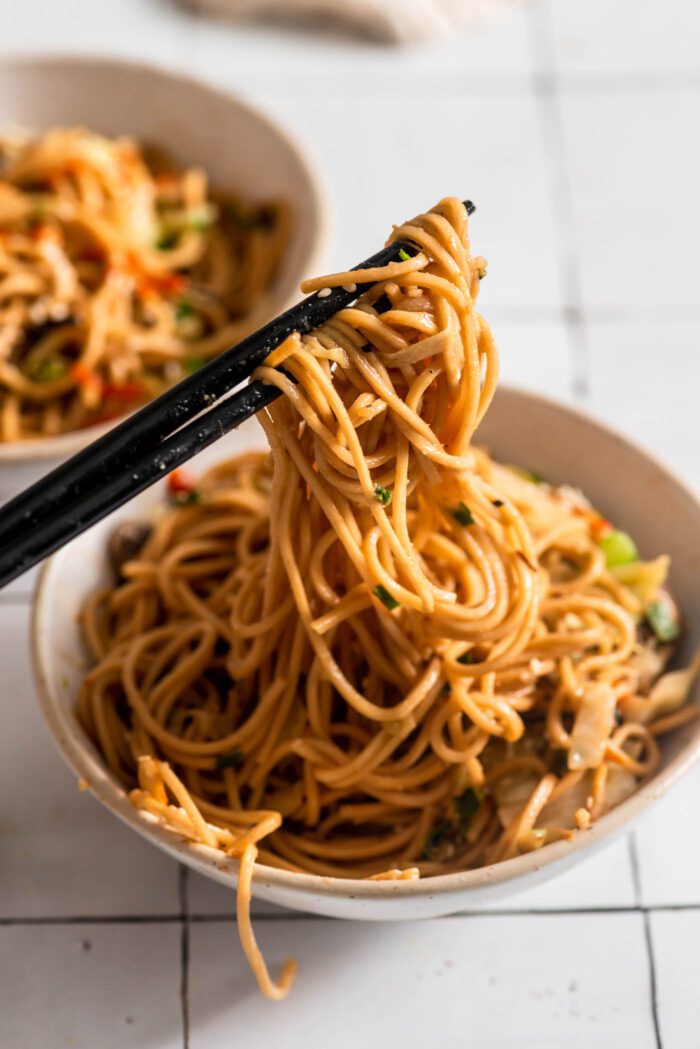
You’ve got to try these miso sesame noodles for an easy 20 minutes for a flavour-packed meal you’ll make again and again. Miso pastes adds addictive umami flavour, and when combined with tahini (or peanut butter), the slightly sweet and spicy sauce is the perfect coating for noodles.
The recipe is completely vegan as is and can be customized by adding your choice of protein. It features onion, mushroom, cabbage and green onion but those can be customized as well to suit your preference.
You’ll how quickly these tasty noodles come together too. They’re a great choice for a simple but satisfying meal that’s ready in no time.
Why You’ll Love this Recipe
- Easy: You can have this recipe ready in 20 minutes.
- Simplify: Short on time or just feelin’ lazy? Just make the noodles and sauce for a super quick but tasty meal!
- Dietary Features: The recipe is completely vegan and can be made gluten-free by using gluten-free noodles such as rice noodles.
- Customizable: Add your choice of protein and mix and match the veggies based on availability and preference. Even just the noodles and sauce are delicious!
- Saucy & Addictive: The noodles coated in sweet, spicy, tangy miso sauce are super delicious (and a little too addictive!).
- Crowd-Pleaser: The whole family will love this recipe!
What is miso?
Miso is a Japanese seasoning paste made from fermenting soybeans with salt and koji, the ingredient used for fermentation. Miso may also contains rice, barley, seaweed or other ingredients.
Miso comes in a paste and is used to add salty, umami flavour to all kinds of dishes. It’s a wonderful ingredient to keep in your kitchen and can be used in soups, sauces, stews, stir fry and even desserts!
There are a many varieties of miso and they range in texture, flavour and colour. The most common varieties in North America are white (light) miso and red (dark) miso.
White miso paste is light beige or yellow in colour and a bit sweeter than red miso paste. Red miso paste is darker in colour and has a stronger flavour. You can use either in this recipe but I usually use white miso paste because it’s what I tend to keep on hand.
Ingredient & Substitution Notes
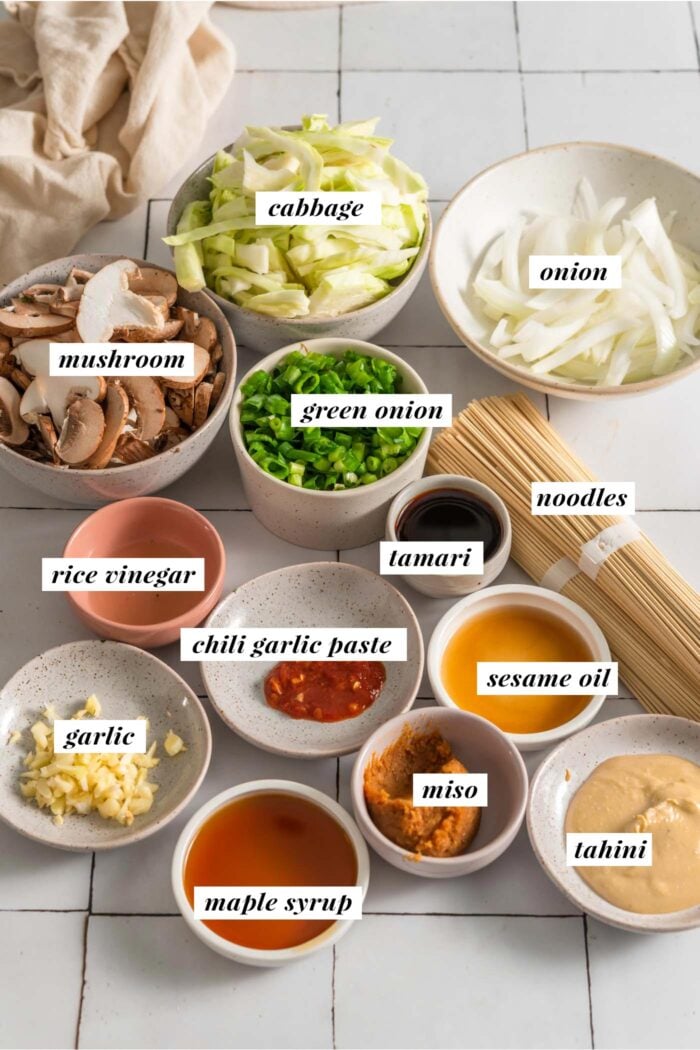
- Miso Paste: Use white or yellow miso paste. Miso paste is available in well-stroked grocery stores or in Asian food stores. If you only have red miso paste, that’s ok to use as well, just note the flavour will be stronger.
- Tahini or Peanut Butter: Tahini will give you miso sesame noodles, peanut butter will have more of a miso peanut flavour. I like tahini here but I’ve made them with both and both are good! For a nut-free be sure to tahini. Sunflower seed butter also works.
- Maple Syrup: Sweetens the sauce. You can also use agave syrup.
- Tamari: If you don’t have tamari on hand, you can use low-sodium soy sauce. If you need the recipe to be gluten-free, be sure to use tamari. If you need a soy-free recipe, you can use coconut aminos.
- Sesame Oil: Do not substitute this with a different oil. It’s key for flavour!
- Chili Garlic Sauce: Use sambal oelek or Sriracha Sauce. This can be omitted or reduced if you’re sensitive to spice (or increased for more heat!).
- Noodles: I suggest dry wheat noodles such as Chinese lo mein or ramen noodles. Soba noodles also work. For a gluten-free noodle, use rice noodles.
- Cabbage: Use green cabbage or napa cabbage.
- Onion: White or yellow onion is suitable.
- Mushroom: I used a mixture of shitake and cremini mushrooms. If you don’t have multiple varieties available, just use one. If there’s an allergy or you don’t like mushrooms, you can leave them out.
- Tofu or Tempeh: Totally optional but I included it as a plant-based protein source if you’d like to add it. Otherwise, disregard that part of the recipe and enjoy the noodles as is or with another protein.
- Toppings: Green onion, sesame seeds, nori and chili garlic paste are all optional but delicious toppings for serving your miso noodles.
How to Make Miso Noodles
Start by bringing a pot of water to a boil on the stovetop to cook your noodles. Once boiling, add your noodles and cook according to the package instructions and drain once finished.
Step 1: Prepare the miso sauce.
Add all of the sauce ingredients to a bowl or container and mix well until smooth.
Quick Note: Start with 1/3 cup water for the sauce. When you add the sauce to the noodles, you may need a little more sauce to adjust the consistency, depending on what kind of noodles you use, as some are more absorbent than others.
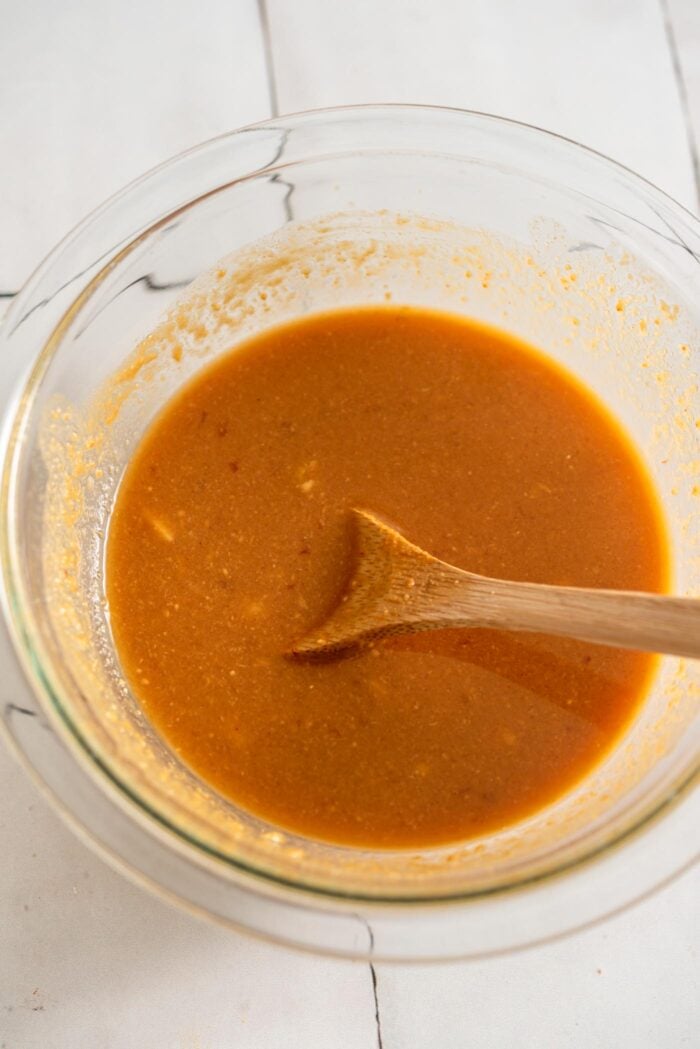
Step 2: Stir fry the vegetables.
Heat 2 tsp oil over medium-high in a large wok or skillet then add the cabbage, mushroom and onion. Stir fry for 4-6 minutes until the cabbage is softened. Add the green onion and stir fry for a few more minutes.
Step 3: Add the noodles and sauce.
Finally, add the cooked noodles and sauce and toss to coat the noodles in sauce. If you need to add a little extra water at this point, add 2 tbsp at a time to adjust the consistency.
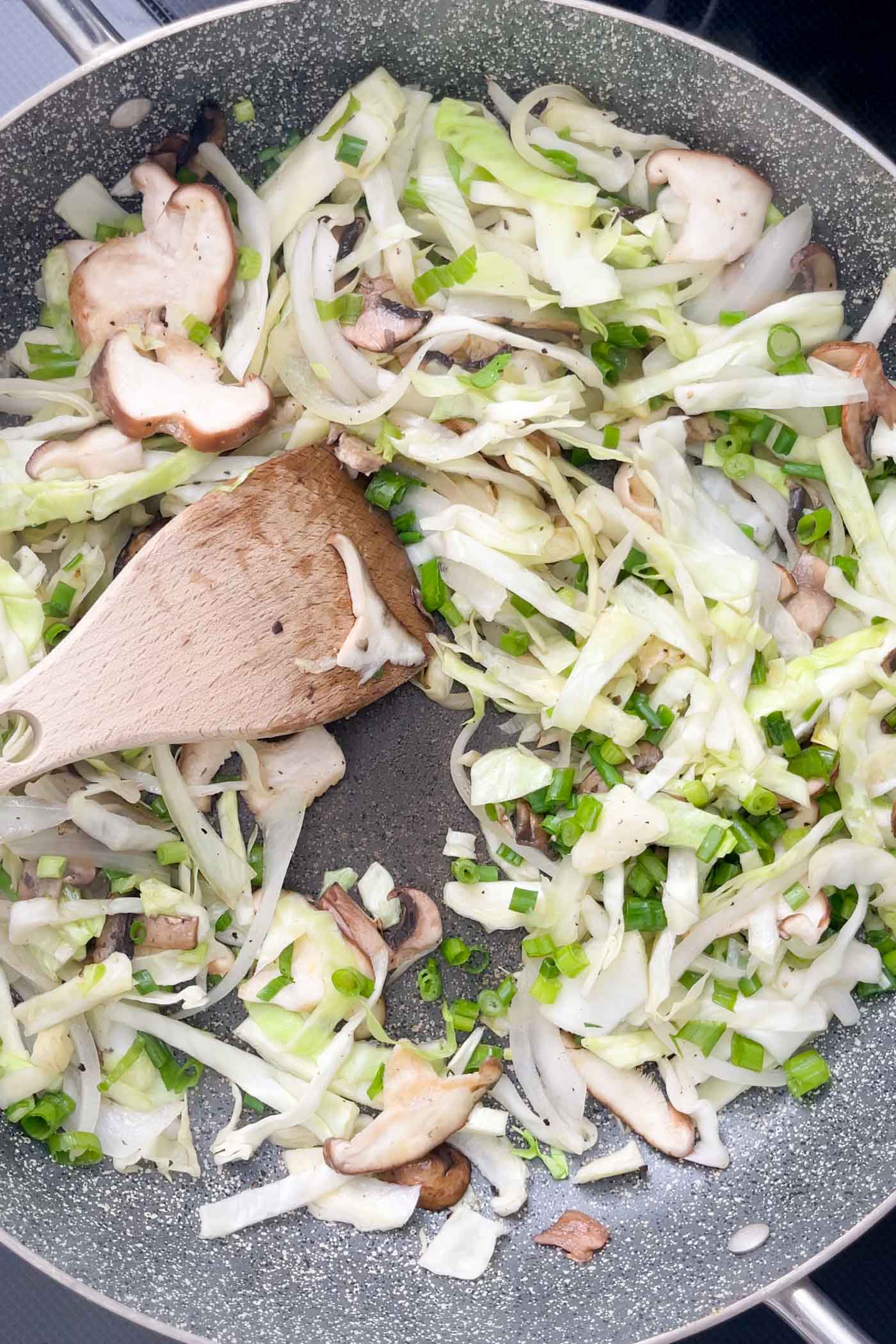
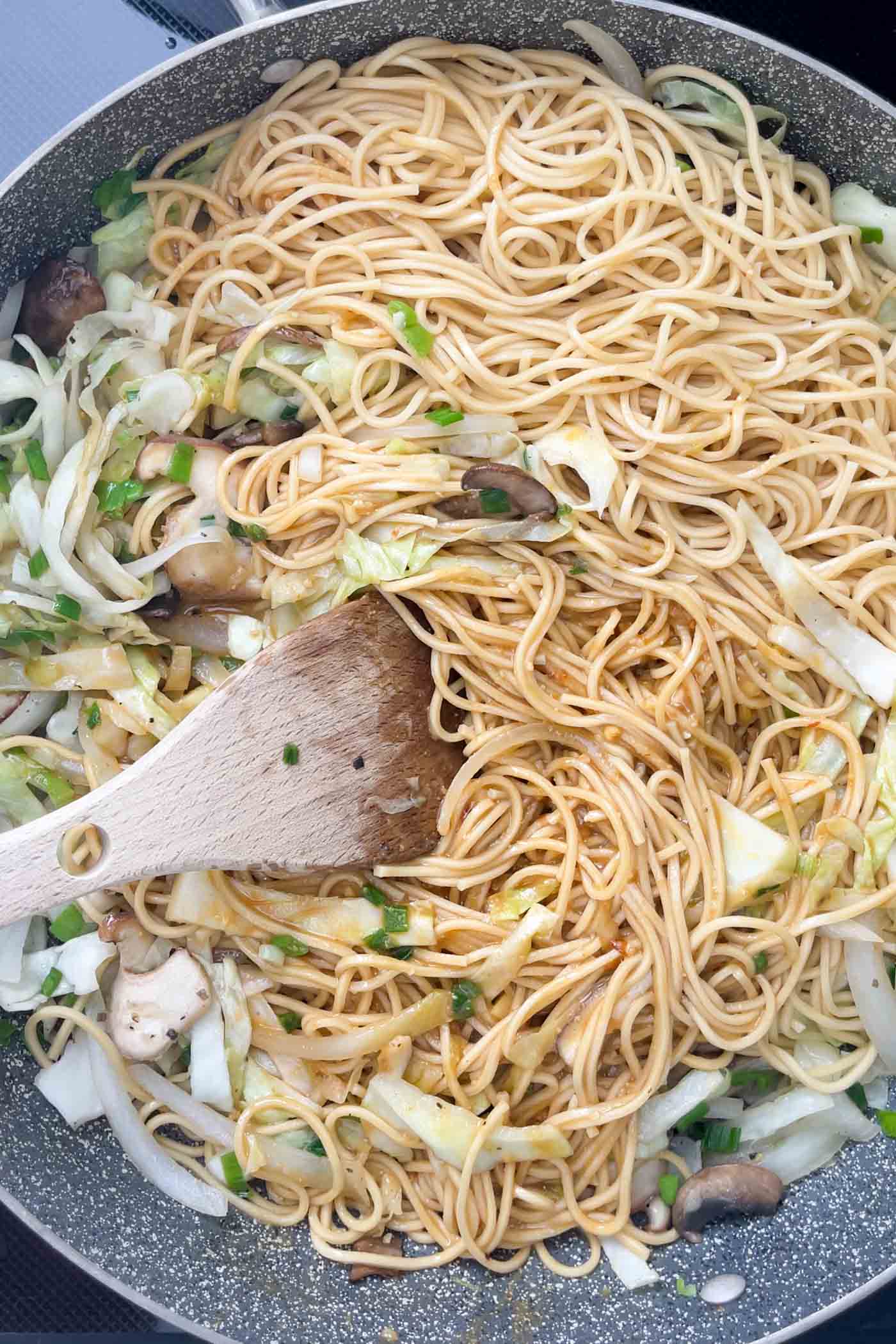
Serve your miso noodles with finely sliced nori, green onions, sesame seeds and if desired, more chili garlic sauce.
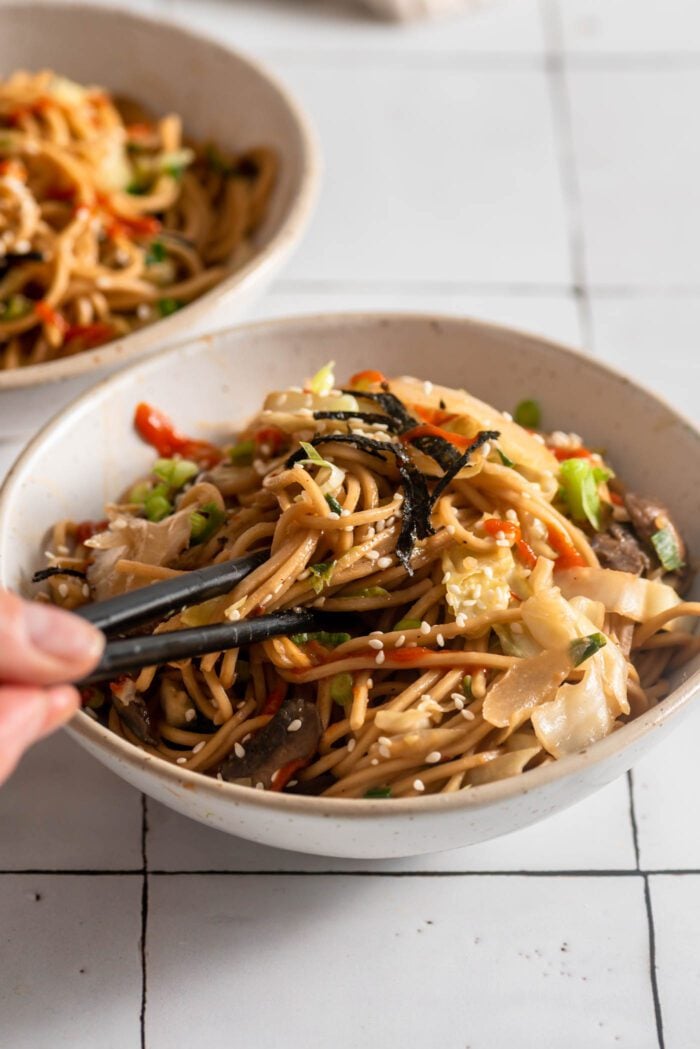
FAQs
To make gluten-free miso noodles, use rice noodles or another gluten-free noodle of choice such as brown rice or quinoa noodles and be sure to use tamari and not soy sauce.
If you don’t like mushrooms or have an allergy, you can just leave them out.
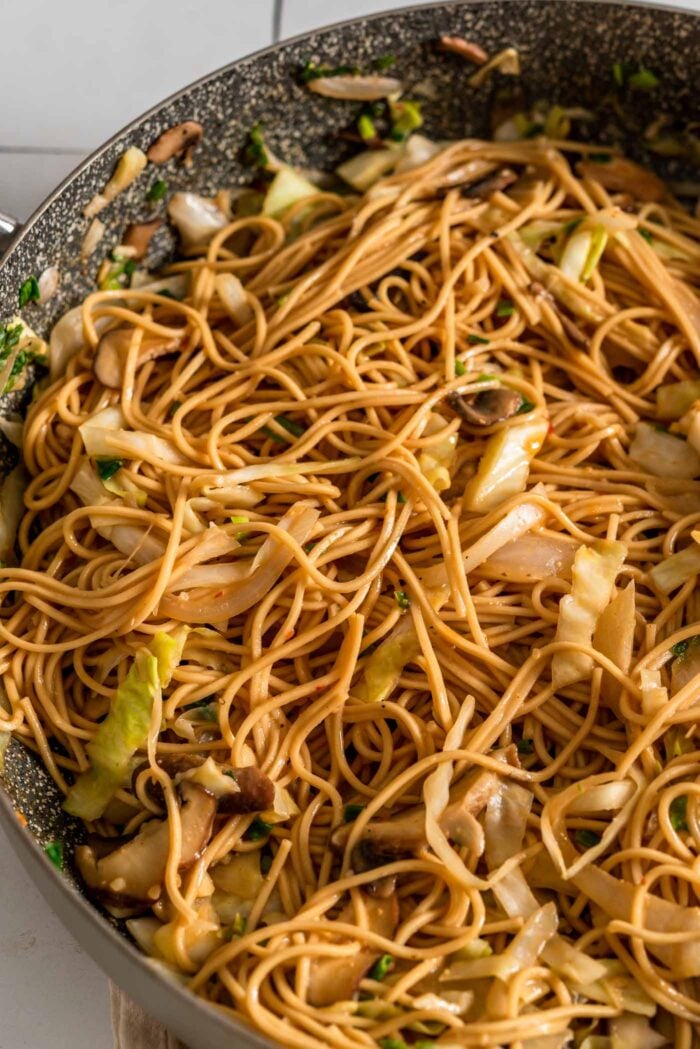
Expert Tips
Vegetables
- Feel free to mix and match the veggies.
- Don’t have cabbage? Leave it out. Don’t like mushrooms? It’s ok to skip them!
- Other veggies that would work are broccoli and shredded cabbage.
- I would recommend keeping it simple to let the sauce and noodles shine but if you prefer, you can add more veggies and less noodles, that works too.
Spice
- If you’re sensitive to spice, reduce or omit the chili garlic paste. You can always leave it out of the sauce and just use it for serving on individual portions.
- Want more heat? Increase the chili garlic paste to 1 tbsp. I like sambal oelek for adding heat to this recipe.
Liquid
- Start with 1/3 cup water when you mix the sauce.
- If you need a bit more moisture once you add the sauce and noodles to the pan, you can add a bit more water as needed.
- This will depend on the noodles used, for example rice noodles are more absorbent than other varieties. You may not need any extra water.
Adding Tofu or Tempeh
If’d you like to add tofu or tempeh to the recipe:
- heat 1 tbsp oil in a large pan over medium-high heat – you can do this before cooking the veggies in the same pan
- once the pan is hot, add cubed tofu or tempeh
- cook for 6-8 minutes, flipping occasionally until browned on all sides
- remove from the pan, drizzle with 1 tbsp of tamari and toss to mis
- set it aside and then use as a topping for your noodles
For more tips and details on making crispy tofu, you can follow this sweet and sour tofu recipe for pan-fried tofu or this peanut bowl recipe for baked tofu. This marinated tempeh recipe is also really good as an alternative to pan frying the tempeh.
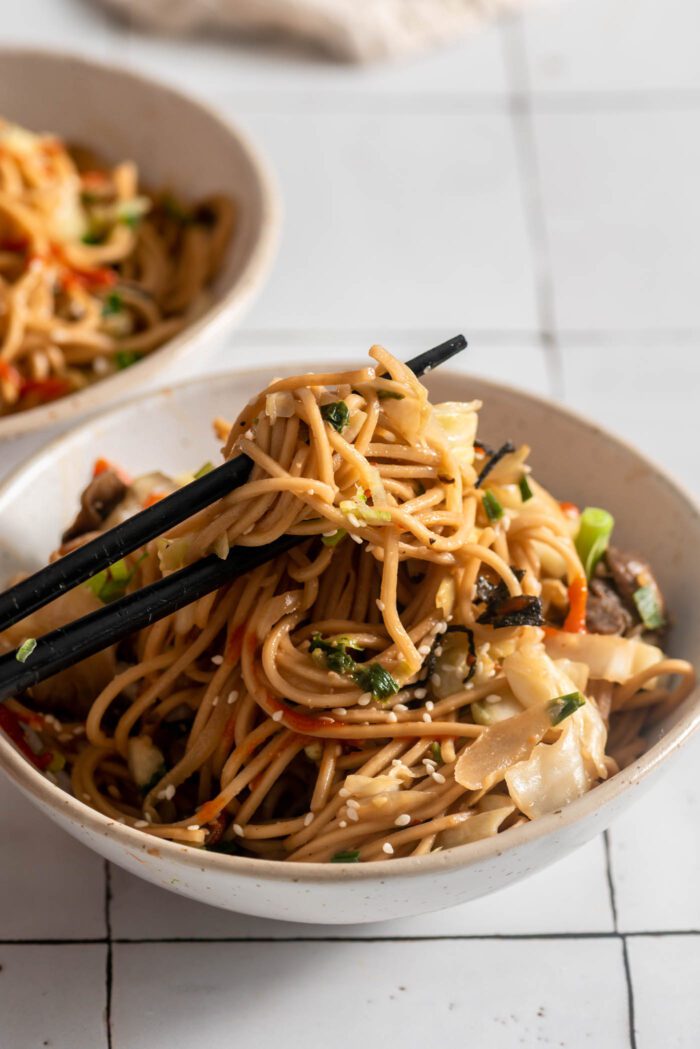
Storing Leftovers
- Miso noodles can be stored in an airtight container in the fridge for up to 4 days.
- They can be eaten cold or reheated in a pan or in the microwave until heated through.
Did you try this recipe? I’d love to hear about it! Click here to leave a review.
Scale
Ingredients
For the Miso Sauce
For the Noodles & Vegetables
Garnishes
Instructions
- Make the Miso Sauce: Add all sauce ingredients to a medium bowl. Stir until smooth. Set aside.
- Cook the Noodles: Prepare noodles according to package directions. Once tender, drain and set aside.
- Cook Tofu or Tempeh (Optional): If using tempeh or tofu, heat 1 tbsp oil in a large pan, over medium-high heat. When the pan is hot, add the tempeh or tofu cubes. Cook for 6-8 min, breaking apart into smaller pieces, until golden-brown. Remove the pan from the heat, then drizzle over 1 tbsp tamari. Toss to combine. Transfer to a plate and set aside.
- Stir Fry the Veggies: Heat 2 tsp oil over medium-high heat. Add the mushrooms, cabbage and onions. Season with a pinch of salt and pepper. Cook for 4-6 min, stirring occasionally, until tender. Add green onions, reserving some for serving. Cook for another 2-3 min, stirring often, until tender-crisp.
- Add Noodles & Sauce: To the pan, add drained noodles and miso sauce. Cook for 1-2 min, tossing gently, to coat noodles in sauce.
- For Serving: Divide noodles between bowls. Top with tempeh (if using), green onions, sesame seeds and toasted nori. Drizzle more chili-garlic sauce over top, if desired.
Notes
Chinese lo mein noodles, ramen or soba would be best here, but rice noodles for a gluten-free option.
The liquid amount may differ depending on what noodles are used, as some noodles are more absorbent ex. rice noodles. If using lo mein or soba, start with ⅓ cup water and add more, if necessary.
Nutrition
- Serving Size: 1/4 of recipe
- Calories: 364
- Sugar: 11 g
- Fat: 8.6 g
- Carbohydrates: 61 g
- Fiber: 5 g
- Protein: 11 g
Keywords: miso noodles, miso sesame noodles
[ad_2]
Source link





More Stories
Pet Food Market – Trends, Industry Competitiveness and Future Outlook
Popular Dessert Courses in Indian Catering
Ragi or Finger Millet – Its Health Benefits and a Quick Dessert